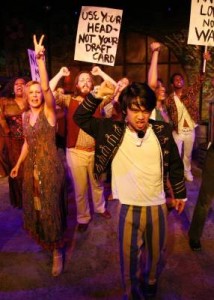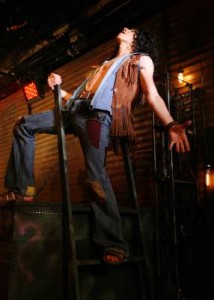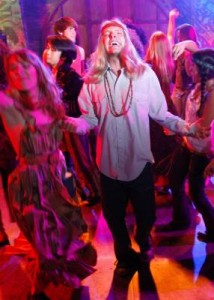
It was mid-1968. LBJ was still President, with Richard Nixon’s election and seven more years of war in Vietnam yet to come. Already, though, there were “tribes” of young people in their teens and twenties whose dissatisfaction with an America riddled with racism, poverty, sexism, sexual repression, and political corruption led them to create the hippie movement of the 60s. More than anything else, though, these “new American patriots,” as they saw themselves, were in revolt against a war they believed to be unjust, unnecessary, and un-American.
Meanwhile, on Broadway, conservatively-dressed New Yorkers, housewives from the suburbs, and out-of-towners from the Midwest were enjoying musical fare like Mame, Sweet Charity, and Promises, Promises. Imagine, then, the reaction of these traditional-looking and thinking theatergoers when Hair: The American Tribal Love-Rock Musical opened on Broadway on April 29, 1968. The show seemed to celebrate profanity, illegal drugs, pacifism, sexual adventurousness, and a disrespect for all things “American.” Just the kind of show for Broadway playgoers to thumb their collective noses at, right?
Well, as anyone with any knowledge of Broadway musicals knows, the answer to this is a big fat wrong. Hair ran for four years and 1750 performances on the Great White Way, spawned an unheard-of simultaneous L.A. production which played two years on Sunset Blvd. in Hollywood, and had an additional eight productions across the U.S. all running at the same time as the show was selling out night after night on Broadway.
Cut to 2009, a full forty-one years later, and Hair is back on Broadway in a Tony-winning revival and (in the tradition of the original production) concurrently playing at the Chance Theater in Anaheim. With wonder-director Oanh Nguyen at the helm, it’s no wonder at all that the Chance’s revival is one of their best musicals ever, and I’d venture to guess, one that can rival (and perhaps even surpass) the original Broadway production in energy, excitement, originality, and performance. Even for Hair “non-fans” like myself, this is a thrilling, inspiring night of theater and one well worth a trek to the O.C.
Galt MacDermot’s music and Gerome Ragni and James Rado’s book are in awesome hands as performed by fifteen of Southern California’s finest young musical theater talents and a sensational four-piece band* led by musical director Bill Strongin. Add to that one of the most spectacular Chance Theater lighting designs ever (by KC Wilkerson), Erika C. Miller’s spot-on 60s hippie garb, Casey Holm’s terrific sound design, and Christopher Murillo’s great, grungy brick and corrugated steel set and this is a Hair that will rock the socks off baby boomers of the Hair generation and their children and (hard to believe) grandkids alike.
Hair unfolds as a series of nearly forty songs running the gamut of emotions and styles from the joy and optimism of “Aquarius” to the sad introspection of “Easy To Be Hard” to the sunny innocence of “Good Morning Starshine,” each a production number in and of itself—strung together with a shoestring of a plot. In a nutshell, roommates Claude (James May), Berger (Armando Gutierrez), and Sheila (Michaelia Leigh) share a complex three-way friendship/love triangle complicated by a national draft that is likely to send one if not both of the men to Vietnam. That’s it. Other major characters include Hud (David LaMarr), a proud representative of the 60s Black Is Beautiful movement; Jeanie (Emily Clark), a pretty blonde impregnated by “some crazy speed freak” and in love with Claude; Woof (Cody Clark), a self-declared non-homosexual with a love thing for Mick Jagger; and Chrissy (Jenna Romano), a flower child hoping for a second chance meeting with “Frank Mills,” who “lives in Brooklyn somewhere and wears this white crash helmet.”
Easily the Chance’s best musical since the equally imaginatively staged Assassins, Hair once again proves Nguyen to be one of Southern California’s most gifted directors—whether staging an intimate drama like Rabbit Hole or a forty-scene musical like Hair. Nguyen makes sure that each and every one of Hair’s dozens of musical numbers has its own unique style, incalculably abetted by Wilkerson’s award-worthy lighting, a psychedelic blend of multi-colored lights and spinning lasers, hand-held electric candles, and in one particularly memorable moment, a rotating mirror ball filling the theater with dancing stars for “Good Morning Starshine.” Kelly Todd’s groovy choreography (could a 60s musical have any other kind?) lets each performer/character express his or her personality through dance.
The original Broadway cast had a then revolutionary multi-racial cast with fully one-third of the ensemble African American. The Chance being in the O.C., one of Nguyen’s challenges was to find ways to stage numbers like “Black Boys” and “White Boys” with only three black performers in a cast of fifteen. In this, the ingenious director is largely successful. A gorgeous-voiced Amber J. Snead (who opens the show with a powerful “Aquarius”) lead sings “White Boys,” backed by Asian Leigh Louise Kato, Latina Alex Bueno, and White male Clark (he of the Mick Jagger crush). There being only two African American males in the cast, “Black Boys” lead singer Ashley Nordland must content herself with a photo while lucky backup singers Romano and Raleigh R. Bisbee get the real thing, LaMarr and Dez Rhoden. Filipino American Sean Cruz is featured in two very funny blackouts which make gentle light of the fact that the original Hair was Asian-free.
Nguyen’s most striking and memorable directorial inspirations are the finales to the show’s two acts. Yes, Act One does end with the famous/infamous 20-second-or-so nude sequence that became one of the show’s biggest selling points, and yes it is so brief and artfully lit that to paraphrase Jack Benny’s reaction to the original staging, you probably won’t be able to notice if any of the boys are Jewish. But unlike most Hairs, the tribe doesn’t undress under a scrim and then emerge in their birthday suits. How the nude scene has been restaged by Nguyen won’t be revealed here except to say that it makes beautifully clear that for the tribe, nudity, protest, and freedom were inextricably linked. As for the Act Two ending, I’ll simply credit Nguyen’s brilliant imagination and the contributions of projection designer John MacDonald for a climax that hits like a punch to the gut (and one that could not have been staged in this way before 1982). If you want to know why the tribe were protesting, this Hair’s final fade-out will leave no doubt in your mind.
Hair try-outs brought out the largest number ever of Chance Theater auditioners, insuring that the cast would be composed of the very best young musical theater talent the O.C. has to offer, beginning with a stunningly dynamic star performance by Gutierrez. The young triple threat, whose comedic/dramatic turn as Eugene in Neil Simon’s Biloxi Blues was one of the finest of 2007, seems liberated by Berger’s shoulder length mane (a wig). He performs with unrestrained animal energy, commanding the stage with gender-crossing sex appeal. May brings a natural sweetness to the role of Claude, making him a perfect counterpoint to Gutierrez, and sings the emotional “Where Do I Go” to powerful effect. Leigh does excellent work in the largest female role, and gets to sing two of the show’s best-known songs, “Easy To Be Hard” and “Good Morning Sunshine.”
As he did in The Girl, The Grouch, And The Goat, David LaMarr steals every scene he’s in. That his macho, badass Hud couldn’t be more different from Girl Grouch Goat’s flamboyant narrator is proof of the young actor’s talent and versatility. “Colored Spade,” “I’m Black,” and “Yes, I’s Finished On Y’alls Farmlands” are Hud/LaMarr highlights.
As pregnant Jeanie, Clark’s combination of beauty and comedic chops makes her performance and her rendition of “Air” standouts. Clark’s brother Cody is an endearing Woof, and gets to sing “Sodomy,” which has more three-and-four-syllable sex terms in it than any song in memory. Kato is very funny as a gray-haired matron named Margaret Mead, who believes that people should be allowed to do whatever they want as long as they don’t hurt anyone else, and says so in song, in “My Conviction.” (Kato has the show’s most gorgeous soprano.) Romano’s rendition of “Frank Mills” is at once sweet, touching, and funny. The all-around sensational cast is completed by Michael Lopez as Hiram.
Though in many ways the once oh-so-contemporary Hair has become a period piece, the issues it raises remain as relevant as ever. One can’t help wondering how much more politically involved 2009’s American young would be if today’s volunteer American army were made up instead of hundreds of thousands of draftees (many of them not particularly willing to go over and die in Vietnam). Hair reminds us of a time when simply being a young American man in his late teens or early twenties was a matter of life and death. The Chance’s Hair is a joyous but ultimately thought-provoking look back at that time.
*Strongin (Bass), Alan Corcoran (Keyboard), Kyle Cahill (Guitar), Bryan Barton (Drums).
The Chance Theater, 5555 E. La Palma Ave., Anaheim Hills.
www.chancetheater.com
–Steven Stanley
July 11, 2009
Photos: Doug Catiller





 Since 2007, Steven Stanley's StageSceneLA.com has spotlighted the best in Southern California theater via reviews, interviews, and its annual StageSceneLA Scenies.
Since 2007, Steven Stanley's StageSceneLA.com has spotlighted the best in Southern California theater via reviews, interviews, and its annual StageSceneLA Scenies.







 COPYRIGHT 2024 STEVEN STANLEY :: DESIGN BY
COPYRIGHT 2024 STEVEN STANLEY :: DESIGN BY